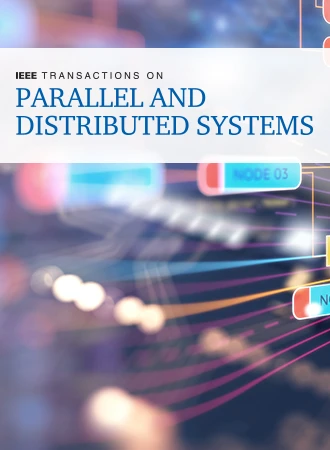Towards Efficiency and Decentralization: A Blockchain Assisted Distributed Fuzzy-Rough Feature Selection
IF 5.6
2区 计算机科学
Q1 COMPUTER SCIENCE, THEORY & METHODS
IEEE Transactions on Parallel and Distributed Systems
Pub Date : 2025-06-09
DOI:10.1109/TPDS.2025.3578032
引用次数: 0
Abstract
Fuzzy-rough sets-based feature selection (FRFS), as an effective data pre-processing technique, has drawn significant attention with the growing prevalence of large-scale datasets. However, centralized FRFS approaches suffer from the following shortcomings: 1) low computational efficiency, 2) bottlenecks in memory and computational resources, and 3) strict limitation of collaborative implementation using non-shared datasets owned by different data providers. These limitations highlight the growing necessity of integrating FRFS into a distributed FS framework. Nevertheless, most existing distributed FS schemes are reliant on a designated central server to collect and merge the local results from all slave nodes, which may result in several challenges including single point of failure risk, lack of trust and reliability, and lack of transparency and traceability. To relieve the above issues, this paper proposes a blockchain assisted distributed FS framework, successfully implementing a distributed solution for FRFS (BDFRFS). First, this framework introduces blockchain to merge, reach consensus and publish the global results generated during each iteration of FRFS, including the currently selected feature subset with its corresponding similarity matrix and dependency degree. This not only eliminates the reliance of central server and alleviates the burden on the central server, but also enhances the credibility and traceability of the results. Additionally, the implementation of FRFS is designed within this framework, utilizing three strategies to improve the efficiency of centralized FRFS: 1) eliminating the irrelevant and redundant features prior to the executing FRFS; 2) removing redundant and unnecessary computations involved in generating the similarity matrices; and 3) enabling parallel computation of dependency degrees. Finally, the experimental results conducted on eight large-scale datasets demonstrate that the proposed framework can significantly reduce the runtime cost and improve the classification accuracy compared to centralized FRFS and several distributed FS approaches.面向效率与去中心化:区块链辅助分布式模糊粗糙特征选择
基于模糊粗糙集的特征选择(FRFS)作为一种有效的数据预处理技术,随着大规模数据集的日益普及而受到广泛关注。然而,集中式FRFS方法存在以下缺点:1)计算效率低;2)内存和计算资源存在瓶颈;3)使用不同数据提供者拥有的非共享数据集进行协同实现受到严格限制。这些限制突出了将FRFS集成到分布式FS框架中的日益增长的必要性。然而,大多数现有的分布式FS方案都依赖于指定的中央服务器来收集和合并来自所有从节点的本地结果,这可能会导致一些挑战,包括单点故障风险、缺乏信任和可靠性、缺乏透明度和可追溯性。为了解决上述问题,本文提出了区块链辅助分布式FS框架,成功实现了FRFS的分布式解决方案(BDFRFS)。首先,该框架引入区块链对FRFS每次迭代产生的全局结果进行合并、协商一致并发布,包括当前选取的特征子集及其对应的相似矩阵和依赖程度。这不仅消除了对中央服务器的依赖,减轻了中央服务器的负担,而且增强了结果的可信度和可追溯性。此外,在此框架内设计了FRFS的实现,采用三种策略来提高集中式FRFS的效率:1)在执行FRFS之前消除不相关和冗余的特征;2)去除生成相似矩阵过程中涉及的冗余和不必要的计算;3)实现依赖度的并行计算。最后,在8个大规模数据集上进行的实验结果表明,与集中式FRFS和几种分布式FS方法相比,该框架可以显著降低运行时间成本,提高分类精度。
本文章由计算机程序翻译,如有差异,请以英文原文为准。
求助全文
约1分钟内获得全文
求助全文
来源期刊

IEEE Transactions on Parallel and Distributed Systems
工程技术-工程:电子与电气
CiteScore
11.00
自引率
9.40%
发文量
281
审稿时长
5.6 months
期刊介绍:
IEEE Transactions on Parallel and Distributed Systems (TPDS) is published monthly. It publishes a range of papers, comments on previously published papers, and survey articles that deal with the parallel and distributed systems research areas of current importance to our readers. Particular areas of interest include, but are not limited to:
a) Parallel and distributed algorithms, focusing on topics such as: models of computation; numerical, combinatorial, and data-intensive parallel algorithms, scalability of algorithms and data structures for parallel and distributed systems, communication and synchronization protocols, network algorithms, scheduling, and load balancing.
b) Applications of parallel and distributed computing, including computational and data-enabled science and engineering, big data applications, parallel crowd sourcing, large-scale social network analysis, management of big data, cloud and grid computing, scientific and biomedical applications, mobile computing, and cyber-physical systems.
c) Parallel and distributed architectures, including architectures for instruction-level and thread-level parallelism; design, analysis, implementation, fault resilience and performance measurements of multiple-processor systems; multicore processors, heterogeneous many-core systems; petascale and exascale systems designs; novel big data architectures; special purpose architectures, including graphics processors, signal processors, network processors, media accelerators, and other special purpose processors and accelerators; impact of technology on architecture; network and interconnect architectures; parallel I/O and storage systems; architecture of the memory hierarchy; power-efficient and green computing architectures; dependable architectures; and performance modeling and evaluation.
d) Parallel and distributed software, including parallel and multicore programming languages and compilers, runtime systems, operating systems, Internet computing and web services, resource management including green computing, middleware for grids, clouds, and data centers, libraries, performance modeling and evaluation, parallel programming paradigms, and programming environments and tools.
 求助内容:
求助内容: 应助结果提醒方式:
应助结果提醒方式:


